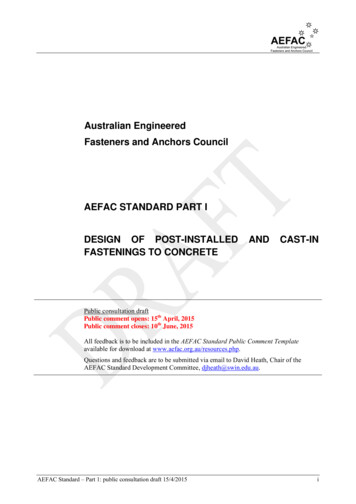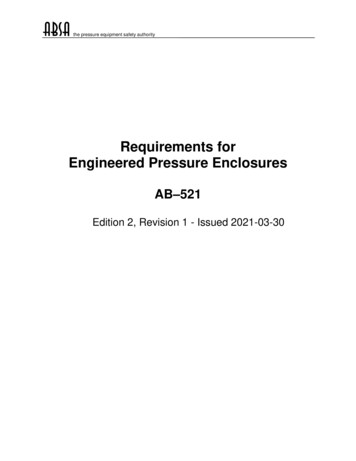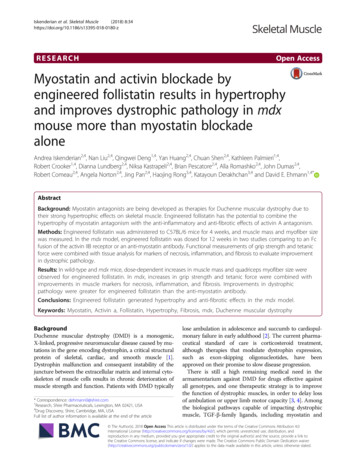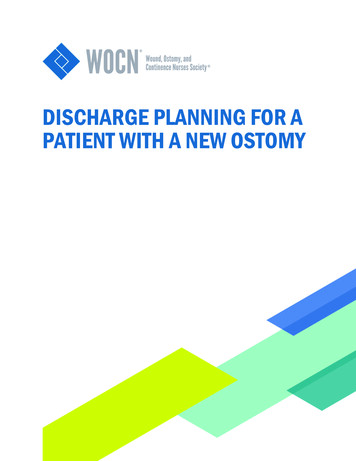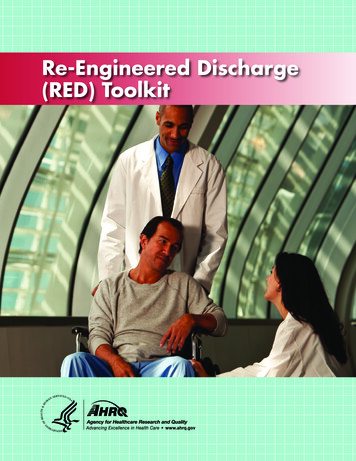
Transcription
Re-Engineered Discharge(RED) Toolkit
The authors of this guide are responsible for its content. The opinions expressed in thisdocument are those of the authors and do not reflect the official position of the Agency forHealthcare Research and Quality or the U.S. Department of Health and Human Services.Statements in the guide should not be construed as endorsement by the Agency for HealthcareResearch and Quality or the U.S. Department of Health and Human Services.
Re-Engineered Discharge(RED) ToolkitPrepared for:Agency for Healthcare Research & Quality (AHRQ)U.S. Department of Health and Human Services540 Gaither RoadRockville, MD 20850www.ahrq.govContract No. HHSA290200600012iPrepared by:Boston UniversityBrian Jack, M.D.Michael Paasche-Orlow, M.D., M.P.H.Suzanne Mitchell, M.D.Shaula Forsythe, M.P.H.Jessica Martin, M.A., M.P.H.Agency for Healthcare Research and QualityCindy Brach, M.P.P.AHRQ Publication No. 12(13)-0084March 2013
AcknowledgmentsWe would like to thank the following consultants who gave feedback on earlier versions of this tool:Linda Barnes, M.D.; William Barron, M.D.; Frances Bonardi, R.N.; Erica Dobson, Pharm.D.; LukeHansen, MD; Steve Martin, M.D.; Carol Mostow, LICSW; Victoria Parker, D.B.A.; and Jeff Ring,M.D.We would also like to thank the hospitals who implemented the RED using an earlier version of thistoolkit and provided insights that were used in finalizing the toolkit.Finally, we thank Carol VanDuesen Lukas, Ed.D., and Sally Holmes, M.B.A., from the BostonUniversity School of Public Health for conducting interviews and compiling lessons learned.Suggested Citation:Jack BW, Paasche-Orlow MK, Mitchell SM, et al. An overview of the Re-Engineered Discharge(RED) Toolkit. (Prepared by Boston University under Contract No. HHSA290200600012i.)Rockville, MD: Agency for Healthcare Research and Quality; March 2013. AHRQ Publication No.12(13)-0084.iiRe-Engineered Discharge (RED) Toolkit:
Table of ContentsTOOL 1: OVERVIEW.1Purpose of the Toolkit. 1Reasons To Re-Engineer Your Discharge Process. 1Impact of RED. 3New and Improved RED Toolkit. 4References. 5TOOL 2: HOW TO BEGIN IMPLEMENTATION OF RE-ENGINEERED DISCHARGEAT YOUR HOSPITAL.7Purpose of This Tool. 7Eleven Steps To Implement the Re-Engineered Discharge. 7Step 1: Make a Clear and Decisive Statement. 7Step 2: Identify Your Implementation Leadership. 8Step 3: Analyze Your Readmission Rates and Determine Your Goal. 10Step 4: Identify Which Patients Should Receive the RED. 11Step 5: Create Your Process Map. 12Step 6: Revise Current Discharge Workflow To Eliminate Duplication. 12Step 7: Assign Responsibility for RED Components. 13Step 8: Train Discharge Educators and Followup Telephone Callers. 15Step 9: Decide How To Generate the “After Hospital Care Plan”. 16Step 10: Provide the RED for Diverse Populations. 16Step 11: Plan To Measure the Progress of RED Implementation. 17References. 17Sample Training Agenda. 19TOOL 3: HOW TO DELIVER THE RE-ENGINEERED DISCHARGEAT YOUR HOSPITAL.21Purpose of This Tool. 21Role of the Discharge Educator. 21The After Hospital Care Plan. 24What Are the Components of the After Hospital Care Plan?. 24What Is the Patient Information Workbook and the RED Workstation?. 25Steps To Deliver the In-Hospital RED Components. 25Obtain and Review Patient Information From Medical Records. 25Confer With the In-Hospital Medical Team. 26Arrange To Meet With Patient, Family, and Other Caregivers. 27First Meeting With the Patient. 27Re-Engineered Discharge (RED) Toolkitiii
Engage in Daily Interactions With the Patient. 29Make Appointments for Followup and Postdischarge Tests/Labs. 30Follow Up on Test or Lab Results That Are Pending at Discharge. 32Organize Postdischarge Medical Equipment and At-Home Services. 32Identify the Correct Medicines and a Plan for the Patient To Obtain Them. 33Reconcile the Discharge Plan With National Guidelines. 35Teach the Content of a Written Discharge Plan in a Way the Patient Can Understand. 36Assess the Degree of Patient Understanding. 39Review What To Do if a Problem Arises. 40Postdischarge Components of the RED. 41Transmit the Discharge Summary to the Postdischarge Clinician. 41Provide Telephone Reinforcement of the Discharge Plan. 42Staff a Discharge Educator Help Line. 42Other Teaching Opportunities Included in the AHCP. 42Components of the After Hospital Care Plan. 43TOOL 4: HOW TO DELIVER THE RE-ENGINEERED DISCHARGE TODIVERSE POPULATIONS.47Purpose of This Tool. 47Role of Culture, Language, and Health Literacy in Readmissions. 47Culture and Its Relationship to Readmissions. 47Language and Its Relationship to Readmissions and Patient Safety. 48Health Literacy and Its Relationship to Readmissions. 48Preparations for Providing the RED to Diverse Populations. 49Hiring Bilingual, Bicultural Discharge Educators. 49Providing Cultural and Linguistic Competence Training. 49Ensuring Availability of Interpreter and Translation Services. 50Overview of Delivering the RED to Diverse Patient Populations. 50Getting Started With the RED for Diverse Populations. 52Assessing Communication Needs. 52Using Nonverbal Communication Styles While Teaching the RED. 53Understanding Health Beliefs, Alternative Healers, and Attitudes About Medicines. 53Understanding Patients and Communicating Across Differences. 54Teaching the AHCP to Patients With Limited English Proficiency. 55Using Qualified Medical Interpreters To Create and Teach the After Hospital Care Plan. 56Working With Qualified Medical Interpreters. 56Accessing Interpreters by Phone and Video. 57Handling Patient Refusal of Language Assistance. 57Understanding the Role of Family and Community. 57Additional Considerations. 59Dietary Patterns. 59Religious Observances. 59ivRe-Engineered Discharge (RED) Toolkit:
Gender Preferences. 59Sexual Orientation and Gender Identity. 59Mental Health. 60References. 61TOOL 5: HOW TO CONDUCT A POSTDISCHARGE FOLLOWUP PHONE CALL.63Purpose of This Tool. 63Preparing for the Phone Call. 63Ensure Continuity of Care. 63Learn How To Confirm Understanding. 64Review Health History and Discharge Plans. 64Check Accuracy and Safety of Medicine Lists. 65Identify Problems Patients Could Have With Medicines. 65Arrange for Interpreter Services. 65Conducting the Phone Call. 66Whom and When To Call. 66What To Say. 66Documenting Your Call. 70Communicating With the Primary Care Provider. 70TOOL 6: HOW TO MONITOR RE-ENGINEERED DISCHARGEIMPLEMENTATION AND OUTCOMES.73Purpose of This Tool. 73Getting Started. 73Selecting and Specifying Measures. 73Implementation Measures. 74Is the RED Being Delivered to Target Patients?. 74Is the Correct Information Being Collected?. 75Is Evidence-Based Care Being Delivered?. 75Is Appropriate Followup Care Being Arranged?. 76Are Patients Being Prepared for Discharge?. 76Are Patients Receiving Postdischarge Care?. 77Selecting Implementation Measures. 77Outcome Measures. 78Hospital Reutilization Measures. 79Connections With Outpatient Providers. 80Knowledge for Self-Management. 80Patient Satisfaction. 81Collecting Data. 81RED Workbooks and Contact Sheets. 81Electronic Health Records and the RED Workstation. 81Re-Engineered Discharge (RED) Toolkitv
Patient Surveys. 81Measurement Timing and Frequency. 82Other Means of Monitoring the RED. 83Root Cause Analysis. 83Discharge Educator Help Line Logs. 83Direct Observation. 83Taking Action. 84Summary. 84Discharge Measures Used by Other Organizations. 85National Quality Forum Safe Practice Discharge Measures. 85American College of Cardiology H2H (Hospital to Home) Program. 85ABIM, ACP, SHM Care Transitions Performance Measurement Set. 86CMS Safe Transitions Program Technical Expert Panel Recommendations. 86How CMS Measures the “30-Day All-Cause Rehospitalization Rate” on the HospitalCompare Web Site. 88References. 90Samples and Forms: available online at olkit/index.htmlviRe-Engineered Discharge (RED) Toolkit:
Tool 1: OverviewPurpose of the ToolkitA variety of forces are pushing hospitals to improve their discharge processes to reduce readmissions.1Researchers at the Boston University Medical Center (BUMC) developed and tested a set ofactivities and materials for improving the discharge process, which they called the Re-EngineeredDischarge (RED). Research showed that the RED was effective at reducing readmissions andposthospital emergency department (ED) visits.2The Agency for Healthcare Research and Quality (AHRQ) contracted with BUMC to develop thistoolkit to assist hospitals, particularly those that serve diverse populations, to replicate the RED.This overview of the RED toolkit explains why hospitals would want to re-engineer their dischargeprocesses, provides evidence of the RED’s impact, and introduces each tool in the toolkit.The RED consists of a set of 12 mutually reinforcing actions, as outlined in the box below, that thehospital undertakes during and after the hospital stay to ensure a smooth and effective transition atdischarge. The RED is the product of 7 years of work supported by funding from AHRQ and theNational Heart, Lung, and Blood Institute (NHLBI). Preliminary work included intensive studyof the discharge process, borrowing methodologies from engineering to define the RED, such asprocess mapping, failure mode effect analysis, probabilistic risk assessment, root cause analysis, andqualitative analysis.19-21 This toolkit is an enhancement of previous RED resources and introduces anew RED component on overcoming language barriers.Components of the RED1.2.3.4.5.6.7.8.9.10.11.12.Ascertain need for and obtain language assistance.Make appointments for followup care (e.g., medical appointments, postdischarge tests/labs).Plan for the followup o
Researchers at the Boston University Medical Center (BUMC) developed and tested a set of activities and materials for improving the discharge process, which they called the Re-Engineered Discharge (RED). Research showed that the RED was effective at reducing readmiss

